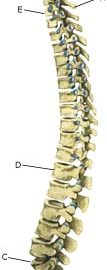|
||
|
||
| Cause: There are several causes for looseness of the lumbar vertebrae (spondylolyse): inborn (dysplastic), fracture of the vertebral arch and degenerative. Fracture of the vertebral arch is the most frequent cause amongst adolescents and athletes, and is seen in 5% of the normal population. It is most often seen in athletes who repeatedly bend the back backwards (high-jumpers, gymnasts, pole vaulters, footballers) (article) (article). In some cases, the looseness can cause one of the vertebrae to slide forwards and apply pressure on the spinal cord (spondylolisthesis).
Symptoms: Pain and stiffness in the lower back (lumbago) and buttocks, occasionally radiating to the leg (“sciatica”). Examination: Slight back discomfort does not necessarily require medical examination, however, all cases with strong or repeated back pain should be examined. The doctor will be able to evaluate whether further examination is required, i.e. x-ray (including lateral projection) (X-Ray) ,(Scintigraphy), CT or MRI scanning (article). Treatment: Treatment is dependant upon the degree of severity. The majority of cases will normally be able to be treated with relief (article-1) (article-2) (which in sever cases must last for several months). In approximately 10% of cases where a vertebra has slid significantly forwards (spondylolisthesis), it will be necessary to operate (article).
however, many other causes of lumbago are found (infection, tumour), of which some will require further examination. Special: Training should be performed on a “lifelong” basis to reduce the risk of relapse after a successful rehabilitation. |


